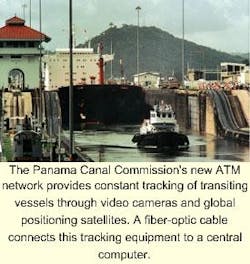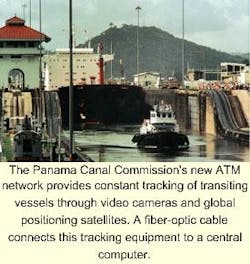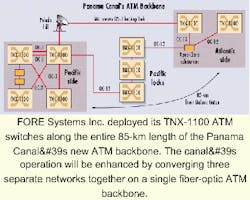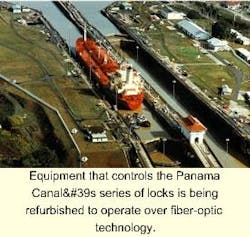The PCC's new network connects nine administrative and navigational buildings with more than 30 mi of linear fiber deployment. Small lengths of fiber connect the center hub with other main hubs in a star configuration, linking more than 3000 desktop PCs along the canal's 80-km distance. The new network will operate at OC-12 (622 Mbits/sec), connecting the switches and hubs to the main telecommunications room with fiber. Workstations will be connected using Category 5 copper cabling, although some high-speed stations will utilize fiber-to-the-desk infrastructure.
FORE Systems Inc. (Pittsburgh) provided the solution for combining all communications traffic onto a single Asynchronous Transfer Mode (ATM) network. FORE is currently assisting the PCC with the migration of traffic from legacy networks onto the new ATM backbone. The network uses multiple TNX-1100 and TN-210 ATM switches from FORE, along with a centralized management feature.
Before selecting ATM, the PCC considered other transmission technologies such as Fiber Distributed Data Interface (FDDI). According to Jorge Ruiz, an electronics engineer in the PCC's Information Management Div., several other ATM vendors were also considered. On-site tests of several brands of equipment were conducted before selecting the FORE solution."The opportunity was perfect because we were going to upgrade one of the existing networks anyway," says Ruiz. "Our data network, which is still operating, is two or three years old and we wanted to integrate all types of services-video, voice, and data-into a single network. So it was the right time for us to implement a new technology that would enable us to work much more efficiently."
Prior to creating the new network, the PCC ran three separate networks for voice, data, and video traffic. Voice transmissions were over copper infrastructure, data used both hybrid fiber/coaxial (HFC) and copper, and video feeds were transmitted via a combination of HFC and microwave technology. Data traffic is currently being shifted from its former token ring configuration onto the new ATM and Fast Ethernet infrastructures. The Fast Ethernet switches for the data portion of the network were obtained from Cisco Systems Inc. (San Jose, CA).
The PCC had several pressing reasons for upgrading to a fiber-optic core network. With the increasing demand for data and the Internet, an upgrade to more bandwidth was inevitable. Also, improved video transmissions made sense as a more efficient way to monitor operations along the canal's three sets of locks. Using both point-to-point and point-to-multipoint video-stream transmissions across the network, the PCC can use the system to conduct meetings and training as well as monitor security and marine traffic. The video applications require substantial bandwidth-bandwidth that only fiber can provide, says Ruiz. But fiber is also replacing much of the electrical cable used to operate machinery along the canal.
"Right now, for example, for the first time since the Panama Canal was constructed, all the machinery at the locks is being refurbished," says Ricardo Segundo, a PCC telecommunications specialist in fiber. "We are eliminating electrical cabling and using fiber-optic technology to connect the various machinery to the control centers. Eventually, everything will be handled over fiber and a separate Internet LAN [local area network] system."
With the integration of all canal operations through the new network, the operations of all three locks can be interconnected over a 50-mi stretch of land. Software is currently under development to manage the new system and provide a much more efficient overall operation.
"For example, if a ship enters the south canal at a certain hour, the people and equipment required for the ship's smooth transit must be ready and available when and where they are needed," says Ruiz. "The only way to control this is to have a centralized, computerized system that handles all the requirements, and we need speed and bandwidth to accomplish that."
The equipment refurbishment began recently on the first set of locks, known as the Pedro Miquel Locks. Next year, the PCC plans to start the conversion from electrical cable to fiber cable at Miraflores Locks and, finally, will begin with the Gatun Locks in two or three years. According to Segundo, this upgrade will involve several million dollars worth of fiber equipment and cable, connectors, and LAN components.The ability to easily track ships passing through the canal is a significant benefit the network offers to the PCC's operations. Pilots boarding the ships will carry a global positioning system (GPS) transceiver that will transmit each vessel's position to a central computer, enabling the controllers to make more efficient use of the canal's resources. The GPS system, says Ruiz, is vital to the canal's overall operations in forecasting traffic loads and planning canal maintenance in advance.
"As the ship reaches certain points, personnel and equipment will be waiting to assist right on time, minimizing the transition time of the ship through canal waters," says Ruiz. "The GPS tran sceivers will be located throughout the canal, connected by hubs and switches to the fiber-optic network."
The project was conceived in 1996 and construction began the following year. The new network was completed early this year from a deployment standpoint; however, the migration of traffic to the ATM core is an ongoing process. Ruiz says more planning is underway to grow the ATM network from OC-12 to OC-48 (2.5 Gbits/sec) by mid-2000. When completed, the entire network could contain 200 linear miles of fiber-optic cable, or a few thousand miles in terms of fiber strands. The PCC is also taking a look at the possible deployment of dense wavelength-division multiplexing and plans to test the technology in the near future.



